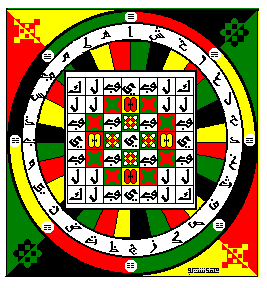Regarding The Significance of This Text
The SIIASI presents this work, the Asaaneed ‘l-Faqeer al-Mu`tarif bi’l-`Ajazi wa’t-Taqseer (The Chains of Authority of the Impoverished One Recognized by His Impotence and Deficiency) for the general public and as an ijaaza for the Umma of Muhammad.
The text was composed on a Wednesday, the 28th of Jumad’l-Awwal, 1213 A.H. (November 7th, 1798 C.E). At the time the Shehu was 45 years old and had already achieved t he spiritual station of qutbaaniyya (spiritual pivot/pole or central point); had reached the level of ijtihaadiyya (independent judgment); and was recognized as the mujaddid (social reformer/renewer) of the 12th century hijra.
he spiritual station of qutbaaniyya (spiritual pivot/pole or central point); had reached the level of ijtihaadiyya (independent judgment); and was recognized as the mujaddid (social reformer/renewer) of the 12th century hijra.
It was composed during the reign of Nafata ibn Yaqubu ibn Baabari over the Gobir Habe` kingdom of Hausaland in the central Bilad ‘s-sudan. Because of the growing appeal of the Shehu and the growth of his jama`at, Nafata and his government, out of enmity and fear, repealed all of the concessions of the social contract that the Shehu had won for the Muslims of Gobir under one of the previous rulers named Bawa in 1205 A.H. (circa 1790 C.E.)
Thus, the text was composed as a form of historical consciousness in order to connect the growing Muslim population to an inter-generational line of authority that gave them a sense of centerdness and confidence in the face increased state repression. This kind of identity construct is extremely important today, in states where Muslims are the victims of systemic and sustained psychological warfare designed to undermine their belief, their customs and way of life.
When at-Thawri asserted that the isnaad is the weapon of the believer, I believe he was talking about times like these where even a Muslim woman wearing her hijab is considered by western states as a form of passive resistance or defense. The fact that the NSA and DOD of the United States would define the wearing of a head scarf as ‘resistance’ and ‘defense’ gives evidence that the state is officially at war with Islam.
The Asaaneed’l-Faqeer is one of the many symbolic weapons and talismans designed to counter the psychological magic of the dominant culture. The Shehu divided the Asaaneed’l-Faqeer into an introduction, ten chapters, and a conclusion; making a total of twelve chapters.
- Chapter One: On the Sanad of al-Faatiha by way of the Jinn.
- Chapter Two: On the Sanad of Qur’anic Recitation.
- Chapter Three: On the Sanad of Tradition of Mercy Connected with first of narrations.
- Chapter Four: On the Sanad of the Famous Books of Prophetic Traditions Among the Scholars of the Umma Which We Have Connected to Its Narrators.
- Chapter Five: On the Chain of the Sanad of Jurisprudence (al-fiqh) and Spiritual Purification (at-tasawwuf).
- Chapter Six: On the Sanad of the Handshake (al-musaafaha) by Way of the al-Mu`amareen.
- Chapter Seven: On the Sanad of the Khirqa as-Suufiyya al-Qaadiriyya.
- Chapter Eight: On the Sanad of the Initiation (talqeen) of the Words of the Shahada Based Upon the Tareeqa ‘l-Qaadiriyya, Khalwatiyya and Mahmudiyya.
- Chapter Nine: On the Sanad of the Dala’il ‘l-Khayraat.
- Chapter Ten: On the Sanad of the Litanies (Ahzaab) of the Qutb Abu’l-Hassan as-Shadhili, may Allah be pleased with him.
In his conclusion, the Shehu cites many scholars who permitted the giving of license in a general manner to as many people as possible. He followed this method because he believed that the asaaneed are [1] the weapon of the community of believers under state repression; [2] an inter-generational connection to the Prophet; [3] a continuation of the mark of distinction by which the Muslim Umma was set apart from other religious communities; and [4] an honor to our Beloved Prophet due to the persistence of his Way until the Day of Judgment.
I received a general, absolute and complete ijaaza in this work from my teacher Shaykh Muhammad al-Amin ibn Adam; who received it from his father Shaykh Adam Kari`angha ibn Muhammad Tukur; who received it from his teacher Shaykh Musa al-Muhajir; who received it from the perfected wali and completely unveiled gnostic Imam and Khateeb `Ali Dinbu ibn Abu Bakr Ma`lami; who received it from the light of the age, the reviver of the religion, the Amir’l-Mu’mineen Shehu Uthman ibn Fuduye`; and I give a general license (ijaaza `aama) to any Muslim who comes across this text, studies it and desires to be a part of the Golden Chain of the awliyya and `ulama cited in this seminal text; and who desire to share in the baraka of Shehu Uthman ibn Fuduye`.
I believe the Shehu wanted the ijaaza for his Asaaneed’l-Faqeer to be given to as many people as possible. I believe this is what the Shehu would have wanted for this Muslim Umma in these final decades of the ‘Zaman’n-Nasaara’ (the Hour of the Christians).
Shaykh Muhammad Shareef bin Farid

Salam alykum Shaykh
I am a student originally from Sokoto. How can I get an isnad from you Shaikh to the books of Shaikh Uthman like the ones in asaneed alfaqeer ? JazakAllah khairan